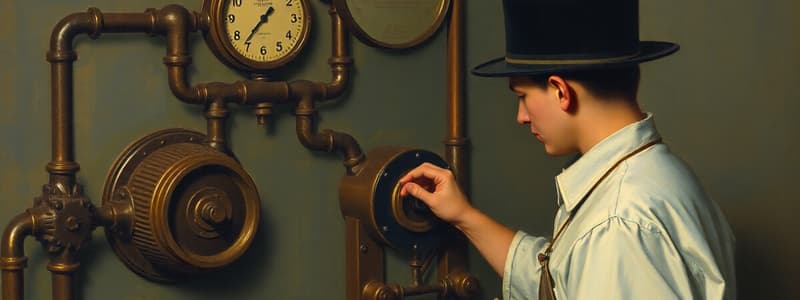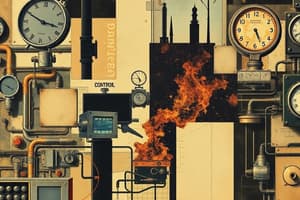Podcast
Questions and Answers
What is the output signal range of electronic transmitters?
What is the output signal range of electronic transmitters?
- 10-30 mA
- 1-5 V
- 0-10 mA
- 4-20 mA (correct)
Which component is NOT part of a control loop?
Which component is NOT part of a control loop?
- Sensor
- Accumulator (correct)
- Controller
- Transmitter
What do pneumatic transmitters primarily use for output signals?
What do pneumatic transmitters primarily use for output signals?
- Voltage changes
- Frequency modulation
- Current changes
- Pressure signals (correct)
In a DCS system, what does the symbol for a computer represent?
In a DCS system, what does the symbol for a computer represent?
What is the primary function of a proportional band in control systems?
What is the primary function of a proportional band in control systems?
Which method is used for converting psi to inches of mercury?
Which method is used for converting psi to inches of mercury?
Which type of control actions can a split range controller perform?
Which type of control actions can a split range controller perform?
What does the term 'bumpless transfer' refer to in control systems?
What does the term 'bumpless transfer' refer to in control systems?
How is specific gravity related to fluid behavior in a tank?
How is specific gravity related to fluid behavior in a tank?
What do delta P transmitters measure?
What do delta P transmitters measure?
Which temperature scale is defined by its freezing point at 0 degrees and boiling point at 100 degrees?
Which temperature scale is defined by its freezing point at 0 degrees and boiling point at 100 degrees?
What is a characteristic of turbulent flow?
What is a characteristic of turbulent flow?
Which device is typically used to measure small fluid flows with precision?
Which device is typically used to measure small fluid flows with precision?
What type of measurement does a displacer float provide?
What type of measurement does a displacer float provide?
Which control valve type is designed to remain open in the event of a failure?
Which control valve type is designed to remain open in the event of a failure?
Which principle explains that an increase in the velocity of a fluid results in a decrease in pressure?
Which principle explains that an increase in the velocity of a fluid results in a decrease in pressure?
What do you call the device that does not come in contact with the fluid, often used for unstable or corrosive fluids?
What do you call the device that does not come in contact with the fluid, often used for unstable or corrosive fluids?
Which measurement tool is best for determining the interface level between two liquids?
Which measurement tool is best for determining the interface level between two liquids?
What term describes fluid flow that is steady and follows smooth paths, without turbulence?
What term describes fluid flow that is steady and follows smooth paths, without turbulence?
Which instrument is often used to measure mass flow, taking temperature into account?
Which instrument is often used to measure mass flow, taking temperature into account?
Flashcards
Temperature Scales
Temperature Scales
Systems for reporting temperature, including Fahrenheit, Celsius/Centigrade, and Kelvin.
Level Instruments
Level Instruments
Devices used to measure the height or depth of liquids or solids.
Bubbler (level instrument)
Bubbler (level instrument)
A device that measures liquid level, using gas bubbling up through it as a measurement.
Flow Measurement
Flow Measurement
Signup and view all the flashcards
Rotameter
Rotameter
Signup and view all the flashcards
Venturi
Venturi
Signup and view all the flashcards
Control Valves
Control Valves
Signup and view all the flashcards
Fail-Open Valve
Fail-Open Valve
Signup and view all the flashcards
Fail-Closed Valve
Fail-Closed Valve
Signup and view all the flashcards
Bernoulli's Principle
Bernoulli's Principle
Signup and view all the flashcards
Process Variables
Process Variables
Signup and view all the flashcards
Control Loop (closed)
Control Loop (closed)
Signup and view all the flashcards
Pneumatic Instrument
Pneumatic Instrument
Signup and view all the flashcards
Electronic Transmitter Output
Electronic Transmitter Output
Signup and view all the flashcards
Set Point
Set Point
Signup and view all the flashcards
Process Error (Offset)
Process Error (Offset)
Signup and view all the flashcards
Proportional Band
Proportional Band
Signup and view all the flashcards
Integral Action
Integral Action
Signup and view all the flashcards
Derivative Action
Derivative Action
Signup and view all the flashcards
Pressure Units Conversion
Pressure Units Conversion
Signup and view all the flashcards
Study Notes
Process Variables and Instrumentation
- Four main process variables are crucial to understanding process control.
- Control loops can be open or closed, affecting control system performance.
- Pneumatic instruments use pressure signals.
- Electronic instruments use electrical signals.
- Digital instruments use binary code.
- Analog instruments use continuous signals.
- Electronic transmitters commonly employ 4-20mA output signals.
- Pneumatic transmitters use 3-15 psi signals.
- Process variable relationships influence system performance.
- Specific gravity relates to density and liquid properties (e.g., sink/float in water).
Control Loops
- Control loops consist of five parts:
- Sensor: Measurers process variable
- Transmitter: Converts signal to usable form
- Controller: Determines set point
- Actuator: Causes a desired change
- Final element (e.g., valve): Makes physical changes
Instrument Signals
- Instrument signals include pneumatic, electronic, and digital formats.
- Loop error accumlates if adjustments are inadequate.
- Calibration is a key process that ensures accuracy.
- Different instrument signals involve milliamps, millivolts, binary codes, and ohms.
Pressure Calculations
- Calculating head pressure (Phead) requires understanding of relevant equations.
- Calculating liquid level involves relationships among pressure, height, and density.
- Converting units of pressure (e.g., psi to inches of water).
- Delta P transmitters measure differences in pressure.
Instrumentation Scaling
- Span, Upper Range Value (URV), and Lower Range Value (LRV) are fundamental concepts concerning instrument ranges.
- Pneumatic and electrical instrumentation both require understanding of scaling parameters.
- Cascade loops use two controllers to enhance control.
Controllers
- Controllers can be manual or automatic.
- Cascade loops feature automatic controllers.
- Process error (offset) arises from discrepancies between set point and process variable.
- Bumpless transfer ensures smooth transitions between control modes.
- Proportional band, integral action, and derivative action are essential controller tuning parameters.
- Split-range controllers manage two valves with different ranges.
- Direct and reverse acting controllers have different output and input actions.
- Ratio controllers manage mixing components according to a specific ratio.
- Controllers track setpoints automatically.
Control Valve Types
- Air to open valves allow process output when air supply is present.
- Air to close valves restrict output with air supply.
- Pressure units conversion (psig to psia and vice versa).
Pressure Measurement Tools
- Manometers measure pressure differences.
- Vacuum represents pressure below atmospheric pressure.
- Density and specific gravity are important when dealing with fluids.
Symbols & Diagrams
- P&IDs use standard symbols for equipment.
- Local and remote instruments are indicated.
- Symbols help identify valves, pumps, transducers, and DCS (computer control systems).
- Block flow diagrams and process flow diagrams illustrate processes.
- Legends explain the meaning of symbols in P&ID.
Heat Transfer
- Heat transfer mechanisms include conduction, convection, and radiation.
- BTU (British Thermal Unit) measures heat.
- Latent heat is associated with phase changes.
- Sensible heat involves temperature changes of single-phase matter.
- Absolute zero represents the absence of molecular motion.
- Temperature scales (Fahrenheit, Celsius, Kelvin) provide different units for measuring temperatures.
Level Measurement
- Level instruments measure liquid levels in tanks.
- Bubbler head pressure measurement doesn't touch the liquid.
- Displacer floats measure liquid levels.
- Tape gauges are used for solids measurement.
- Ultra-sonic devices measure level using time of flight.
- Sight glasses observe the level.
- Dip sticks determine the liquid level.
- Interface levels measure levels between different fluids.
- Differential pressure (DP) cells employ a DP transmitter for measuring liquid levels.
- Level measurement methods include direct and indirect approaches.
Flow Measurement
- Flow quantity measurement pertains to the movement of fluids (liquid or gas).
- Mass flow and volumetric flow are different ways to measure gas flow.
- Mass flow (steam) utilizes LDs measurements.
- Laminar flow is smooth.
- Turbulent flow is irregular.
- Rotameters are precision measuring instruments for low flows.
- Venturi tubes offer low pressure loss.
- Coriolis mass flow meters provide higher accuracy to consider temperature factors.
- Volume, rate, and time calculations involve correct unit conversions.
Control Valves
- Control valves regulate flow.
- Fail-open valves allow output when the supply is lost.
- Fail-closed valves stop output when the supply is lost.
- Control valves have various parts.
Fluid Mechanics
- Bernoulli's principle explains pressure and velocity relationships in fluids.
- Thermodynamic concepts are important to understand fluid behavior
Temperature Measurement
- Various temperature measurement instruments (e.g., thermocouples) exist.
- Thomas Seebeck developed the thermocouple.
Other Instruments
- Analyzers measure components in fluids.
- Load cells relate weight to other values.
Studying That Suits You
Use AI to generate personalized quizzes and flashcards to suit your learning preferences.




